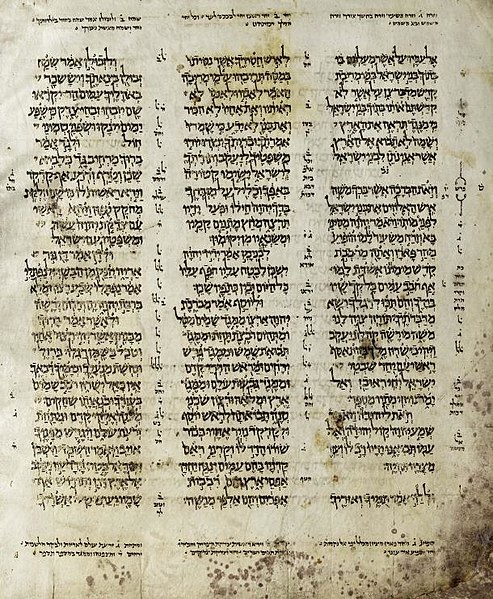Fasciculus:Aleppo Codex (Deut).jpg

Mensura huius perspectionis: 493 × 599 elementa imaginalia. Aliae mensurae: 197 × 240 elementa imaginalia | 610 × 741 elementa imaginalia.
Sua resolutio (610 × 741 elementa imaginalia, magnitudo fasciculi: 132 chiliocteti, typus MIME: image/jpeg)
Historia fasciculi
Presso die vel tempore fasciculum videbis, sicut tunc temporis apparuit.
| Dies/Tempus | Minutio | Dimensiones | Usor | Sententia | |
|---|---|---|---|---|---|
| recentissima | 12:08, 2 Iunii 2007 |  | 610×741 (132 chiliocteti) | Daniel Baránek | {{Information |Description=The Aleppo Codex is a medieval manuscript of the Hebrew Bible (Tanakh), associated with Rabbi Aaron Ben Asher. The Masoretic scholars wrote it in the early 10th century, probably in Tiberias, Israel. It is in book form and conta |
Nexus ad imaginem
Paginae insequentes huic imagini nectunt:
Usus fasciculi per inceptus Vicimediorum
Quae incepta Vici fasciculo utuntur:
- Usus in ar.wikipedia.org
- Usus in bg.wikipedia.org
- Usus in bn.wikipedia.org
- Usus in br.wikipedia.org
- Usus in ca.wikipedia.org
- Usus in ceb.wikipedia.org
- Usus in cs.wikipedia.org
- Usus in da.wikipedia.org
- Usus in de.wikipedia.org
- Usus in en.wikipedia.org
- Judaism
- Masoretic Text
- Textual criticism
- Aleppo Codex
- Tiberian Hebrew
- Parashah
- Dabar (Hebrew word)
- Qere and Ketiv
- V'Zot HaBerachah
- Biblical manuscript
- Portal:Bible/Featured article/February, 2008
- Portal:Bible/Featured article/2008
- User:Trilletrollet
- User:Trilletrollet/Userboxes
- User:Sonia.A.Ibrahim/sandbox2
- User:Trilletrollet/Userboxes/Biblical Hebrew
- Wikipedia talk:WikiProject Userboxes/New Userboxes/Archive 39
- Usus in en.wikiquote.org
- Usus in en.wikisource.org
- Usus in eo.wikipedia.org
- Usus in es.wikipedia.org
View more global usage of this file.



